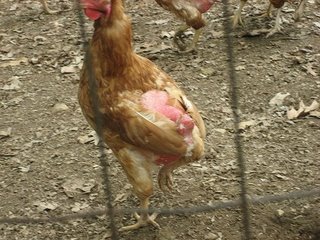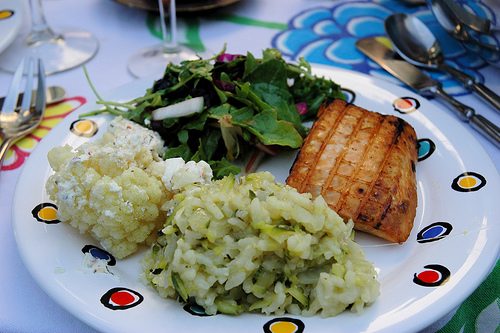Food Prices Too High? Tired of overpriced, undersatisfying meals? Want to have fresh, local food on hand all year-round? Ten Ways looks at eating local, fresh and delicious.
It’s not hard to see the value in local, seasonal food, but how does one go about finding it, preparing it, and saving a little money along the way? Check out this installment of Ten Ways for a few tips on enjoying wonderful food 365 days a year.
-
Grow Something Edible
Planting seeds, starts or other edible living things in and around your home (wild yeast cultures or sprouts count too) are great ways to have fresh, delicious food on hand. Plus, it’s cheap. Seed packages start at less than a dollar, soil or compost can be purchased (or found) at pennies per pound, and water in the form of rain or out of the tap are both economical choices. Aside from an investment of time, growing your own food requires little else.
The rewards of growing your own food are almost endless, but include: less time spent driving to the store, fresh ingredients on hand at all times, an understanding of the seasons, which can help you eat better tasting food (see #2 below), and carbon sequestration in its most delicious form, food.
No matter what your living situation, it is possible for you to grow some food at a very low price premium. Do you live in an apartment with no sunlight or fixed windows, or worse yet, a basement apartment? Never fear, many cities have community gardens that make it possible for city slickers to grow a little food on the side.
Rent a spot for yourself, or split one with friends. It’s a great way to raise some edibles while hanging with your friends. I’ve also described how to grow food on your fire escape in a previous post!
- Seed Savers Exchange – an organization dedicated to preserving heirloom seeds and unusual varieties
- iVillage Garden Web – an open forum on community gardens
- Your local hardware store, nursery or garden center. Call or visit them.
-
Eat Seasonal Food
Food is at its most affordable when it is purchased in season. Not surprisingly, fruits and vegetables are also at their most flavorful and freshest when they are in season. Find out what’s in season in your area at which time of year, and harvest!
As this year’s growing season draws to a close in many parts of the country, people are harvesting their summer and fall crops. This is a great time of year to preserve, dry and can (more about that later), but it’s also a great time to taste the bounty of fresh, delicious food that is out there.
Resources:
- What’s in Season (by state) from Sustainable Table
- Eat Local, Natural Resources Defense Council
- Pick Your Own – Select your state to view the harvest calendar.
- Seasonal Food Guides from Eat Well Guide
-
Cook at Home
Food is more expensive when you eat it at a restaurant. I know, I know: “But I can’t cook!” In most cases, if you can boil water, you can cook a meal at home that will be satisfying, tasty, comfortable, and cheaper than going out to eat. Plus, you can keep some leftovers for tomorrow’s bag lunch.
It’s true, restaurants have a few things that your kitchen and dining room (most likely) don’t: ambiance, sommeliers (fancy wine folk), draft beer, live music, fancy china, and exotic ingredients. These things are great for special occasions, or when you just feel like gettin’ fancy and out of the house.
However, most of us eat our meals out at a burger/pizza/burrito joint, or in the car on the way home. This kind of eating out usually doesn’t have most of the aforementioned luxuries, and has few of the comforts associated with eating at home.
When you cook at home, you decide how spicy your tacos are going to be, or how much chocolate to put in the brownies, or when the spaghetti is al dente. You’ve got all of the freedom, and you can eat dinner in your pajamas or a tuxedo if you want to, eat by yourself without feeling embarrassed, or have twenty of your closest friends over to enjoy a meal with you, and watch a movie later with all the money you saved.
Resources:
- AllRecipes – another great recipe site with lots of user-supplied information, pictures, reviews and comments
- Epicurious – a great site for recipes and tips on cooking in general
- Chowhound – a great site about food and cooking it
- 101 Cookbooks – a great blog with vegetarian and vegan recipes, as well as beautiful photos and instructive comments.
-
Shop at Farmers’ Markets
Local food is fresher than non-local food because it doesn’t have to be picked long before its peak ripeness and shipped cross-country. To boot, if you buy food in season at Farmer’s Markets, you’re probably saving money and getting fresher food than if you were to shop at the Big Box Mart (BBM).
In addition, you might be able to form a relationship with the farmer that grows the food you’re going to eat. They’re usually happy to answer questions about their farming practices, and some farmers may even let you in on information about their harvest calendar to give you a jump on when the freshest tomatoes will be ready, or when the corn is coming to market.
Knowing the people that grow your food, on a personal level, also provides a little extra security if, say, jalapenos are not available at the BBM due to an outbreak of foodborne illness, and you’d like to make salsa that night for a dinner party. Your local farmer might just have a few spare jalapenos on hand, or know someone who does.
Resources:
- Find Farmers’ Markets at Local Harvest using their search tool
- Find a Farmers’ Market from USDA listings and learn about them
- Learn even more from the National Sustainable Agriculture Information Service
-
Join a CSA
Developing that personal relationship with local farmers can go one step further with a harvest box from a Community-Supported Agriculture (CSA) farm. In this case, farmers will sell you a share in their produce for the growing season at a flat rate, and you’ll get a box each week with whatever is freshest on their farm. CSA’s have grown in popularity in recent years, and many farms have long waiting lists.
Some people go in on harvest boxes together to save money, and for those who can afford the investment up front, it ensures that you’ll be able to eat your veggies all year long. Some farms even have an installment payment plan or plans for low-income folks who are interested.
It may be too late to join up this year, but it’s never too late to get to know your local farmers, and when signup time rolls around in the spring, you’ll be on a first-name basis with them.
Resources:
- A great directory of CSAs can be found at Local Harvest
- What is a CSA and how does it work?
-
Cook Simple Meals
If you’ve been cooking for years from gourmet cookbooks that require 15 to 20 ingredients per dish, simple meals may not be in your habit. However, if you’re new to cooking simple dishes may be your ticket to great food at a low price, with tons of flavor. If you start by selecting foods that are in-season or were preserved in-season, simple recipes show off the delicious, fresh ingredients. High-quality ingredients don’t need a lot of dressing up to taste good, so less is more in their case.
Resources:
- Allrecipes.com: Ingredient Search – Enter 4 things you have in your pantry and, viola! recipe du jour.
- RecipeZaar: 5 or Less Ingredients – Ability to search thousands of 5 recipe or less dishes.
- Cooks.com: 5 Ingredients or Less – You get the idea…
-
Have a Potluck
Inviting your friends over for a shared dinner, or meeting at a local spot (park, Elks hall, church, etc.) is a great way to share good food and stay on a budget. There is a bounty when everyone participates, and you can get a much greater variety of good food when you’re joined by 10 others. If you all plan to share your leftovers, there may even be enough for a late-night snack or lunch the next day.
Eating together with friends also connects us with our most basic of human needs, harvesting food and sharing it together with those in our “clan”. We’ve been doing it for thousands of years. Why not make it a regular event, and act like humans together?
Resources:
- In case you need instructions, eHow breaks down planning a potluck
- LuckyPotluck: a site dedicated to – you guessed it – having a potluck!
-
Buy Local Foods
Getting to know your local producers connects you with your food in a unique way. When you know what’s in season in your area, and you know the people who make it on a personal level, the food becomes much more than just sustenance, but is also a community-building event. Knowing the people that produce local food also builds ties in the local community.
By trading your money (that you earned in the community) with local producers of food, you’re keeping the money in your community, not sending it off to the corporate headquarters of BBM. You can find local bakeries, coffee shops, breweries, vegetable markets, ethnic food stores, etc. that are owned by individuals in your community by consulting the phone book, local message boards, or a community hall or meeting place. Look for the local folks, and support your neighbors!
Resources:
-
Use the Whole Thing
Cook a whole chicken. Roast for dinner one night, chicken soup from the stock the next, and pulled chicken tacos the third night, chicken salad sandwiches for lunch the third day. Four meals from one chicken, and that’s without using the bones!
Seriously though, this is a very economical way to cook, and one that is totally enjoyable. These things take time, but the holidays are a great time to practice, and the more you do it, the better you’ll get at it.
The point is, with a few additional ingredients, you can “stretch” the meal out to three or four day’s worth of food and not really feel like you’re eating the same roasted chicken four days in a row. This is frugal, and (as Alton Brown says) Good Eats.
Resources:
- Jamie Oliver on multiple dish cooking, especially chicken
- Chicken Cycle (multiple dishes that cascade from one preparation, like a whole roasted chicken) from An Obsession with Food and Wine
-
Dry, Preserve, and Pickle
We people must preserve food to survive, especially in rough climates. Pickling, drying, or freezing is something that anyone can do, and drying and freezing are two of the cheapest and easiest methods.
Almost anything can be prepared, then frozen, and many things can be frozen whole or raw and added to prepared foods after thawing. Preserving food is a great way to make your food dollars go a little bit further, and you can save your fresh produce for a rainy (or snowy) day.
Resources:
- National Center for Home Food Preservation – Check the Publications section, where the Center has some of their publications and some good info. from other sources.
- Cooperative Extension – Check your local extension university (usually the state school or land-grant university) for publications on food preparation that are usually free. The information is really useful and intended for a wide audience. This is a great resource for any home or garden questions.
Image Credit: mst7022 at flickr under Creative Commons Attribution 2.0 License










Great post on sane, economic, green eating.
Msphillyorganic,
Thanks! You know, it really feels insane sometimes the way that our current, global food system operates. Let’s hear it for sane food choices in an insane environment, and to making those choices the majority!
America the Beautiful Fund’s Operation Green Plant program provides grants of vegetable, flower and herb seed for community planting projects nation wide. We collect donations of surplus seed stock from major American seed companies that would otherwise end up in landfills and grant them out to groups and individuals who garden for hunger relief, nutrition education, habitat preservation (can’t have a garden with out those honey bees!)environmental stewardship and a variety of other good works accomplished through gardening. Help us plant the “Seeds that Grow Hope”!! http://www.freeseeds.us
Great post! I was looking for a comprehensive review on different ways to eat greener. Thanks!
Peggy,
Thanks for the feedback. I’m glad you enjoyed the post. Y’all come back now, ya hear?
I can’t grow food to save my life, but sprouts are very easy, inexpensive and highly nutritious. Great article!
In line with “Grow Something Edible” and “Buy Local Foods” is harvesting something local, especially if you lack room to grow your own. Find friends or neighbors with fruit and vegetable surpluses. Help them with harvesting (and growing if you can). Look for community harvesting organization (ones that harvest for donations to nonprofits), or start one (even if it’s small scale).
I completely agree Farmers’ Markets are the best. They are not only the cheapest, but I find they have so much more flavor. Thanks for the great ideas, sometimes I need to remind myself of what else I could be doing.
Fantastic articles. A little biased since the writer is our son. Farmers markets are great. Simple meals need to be a staple especially with environmental factors and stresses. Growing fresh just tastes so much better than store purchased. Love tomatoes and crave that juicy, fresh taste. Supporting local is really important. Bryan you have opened up avenues for people to enjoy the simple pleasures of healthful food choice. Love it. Parents are proud.
Nice resources to help folks search for local food markets and recipes!
Great post – the Food movement is the best example of things working well at the local level.
We have just acquired 15,000 sq. ft. of manufacturing space in Western New York to spur the development of entrepreneurs looking to can, bottle and produce local products with surplus crop, http://www.summitecosource.com
The Food Movement, Slow Food, Buy Local, Organic Local – is leading the way for sustainable business practices.
Answers:
Manufacture in America
Energy Independence
Shh…www.otoyk.com
You could add http://www.limitedingredients.com to your simple meals resources.